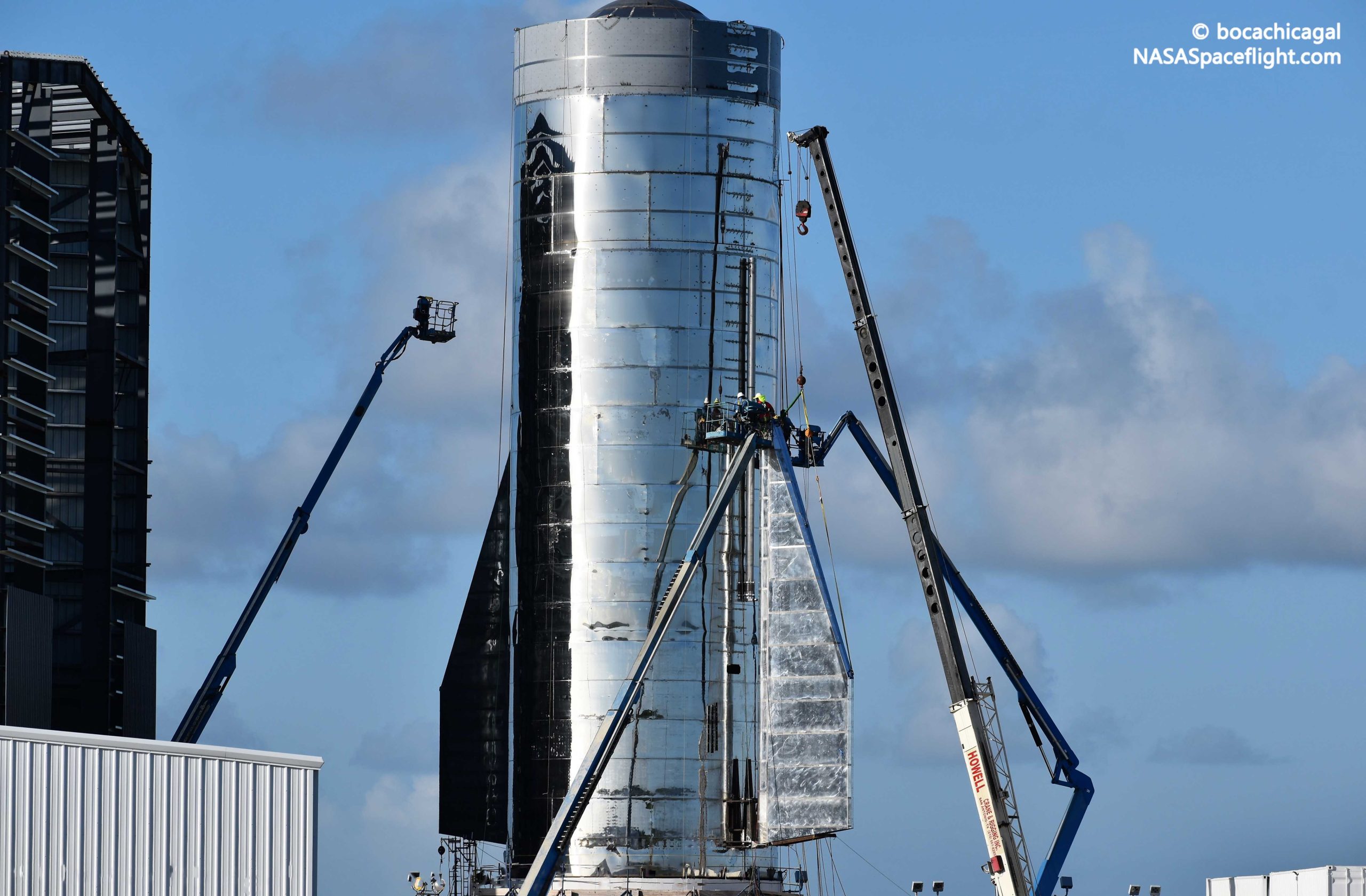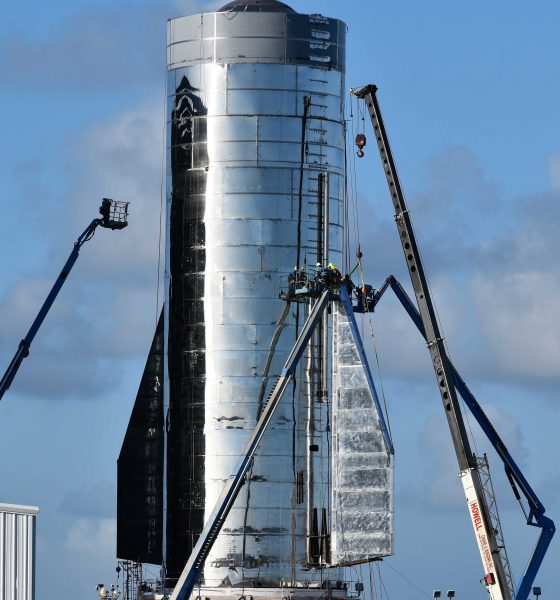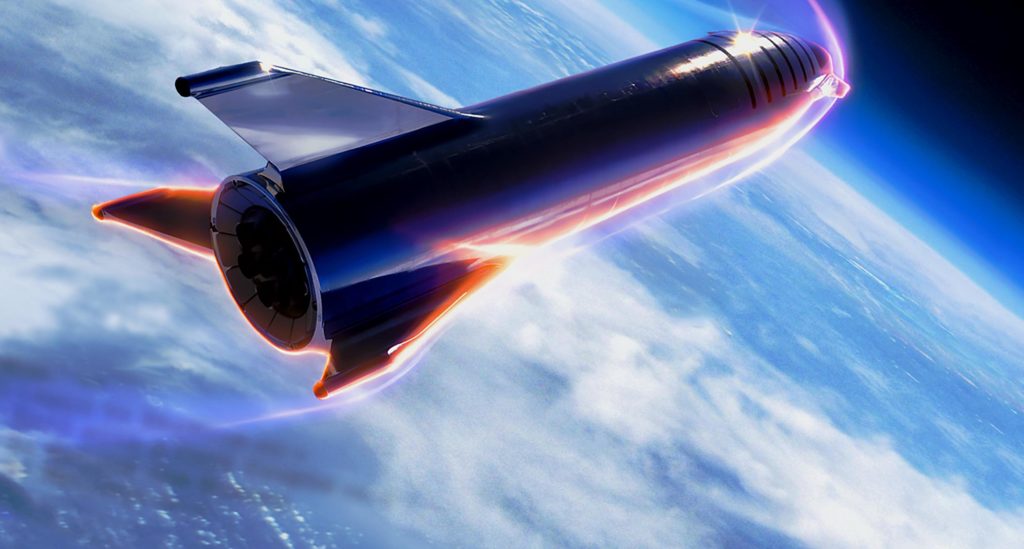

News
SpaceX CEO Elon Musk explains how Starships will return from orbit
In the near future, SpaceX wants to begin putting its first two full-scale Starship prototypes through a series of increasingly challenging test flights, eventually culminating in their first Super Heavy-supported orbital launch attempts.
SpaceX CEO Elon Musk took to Twitter over the last 48 or so hours to answer a number of questions about how exactly Starship is meant to make it through orbital reentries – by far the most strenuous period for the ship and without a doubt the single most challenging engineering problem SpaceX must tackle.

Discussed yesterday on Teslarati, SpaceX technicians began the process of attaching numerous Tesla Model S/X battery packs to a subcomponent that will eventually be installed inside Starship Mk1’s nose, offering a storage capacity of up to 400 kWh. The need for all that power (Crew Dragon relies on a few-kWh battery) is directly related to Starship Mk1’s methods of reentry and recovery, recently described in detail by Elon Musk.
As noted above, ~400 kWh of batteries are needed to power the electric motors that will actuate Starship’s massive control surfaces – two large aft wings and two forward canards/fins. According to Musk, Starship’s “stability is controlled by (very) rapid movement of rear & fwd fins during entry & landing”, meaning that the spacecraft will need to constantly tweak its control surfaces to remain in stable flight.

By far the biggest challenge SpaceX faces is ensuring that Starship can survive numerous orbital-velocity reentries with little to no wear and tear, a necessity for Starship to be cost-effective. In Low Earth Orbit (LEO), Starship will be traveling no less than 7.8 km/s (Mach 23, 17,500 mph) at the start of atmospheric reentry. In simple terms, the process of slowing from orbital velocity to landing on Earth involves turning the vast majority of that kinetic energy into heat. As Musk noted yesterday, this reality is just shy of unavoidable but there is some flexibility in terms of how quickly one wants to convert that energy into heat.
The fastest route to Earth would involve diving straight into the atmosphere, dramatically increasing peak heating on a spacecraft’s surface to the point that extremely exotic heat shields and thermal protections systems become an absolute necessity. SpaceX wants to find a middle ground with Starship in which the spacecraft uses its aerodynamic control surfaces and body to generate lift, slowly and carefully lowering itself into Earth’s atmosphere over a period of 15+ minutes. Musk notes that this dramatically lessens peak heating at the cost of increasing the overall amount of energy Starship has to dissipate, a bit like cooking something in the oven at 300 degrees for 30 minutes instead of 600 degrees for 10 minutes.
To an extent, Starship’s reentry profile is actually quite similar to NASA’s now-retired Space Shuttle, which took approximately 30 minutes to go from its reentry burn to touchdown. Per the above infographic, it looks like Starship will take approximately 20 minutes from orbit to touchdown, owing to a dramatically different approach once it reaches slower speeds. Originally described by Musk in September 2018 and again in recent weeks, Starship will essentially stall itself until its forward velocity is nearly zero, after which the giant spacecraft will fall belly-down towards the Earth, using its wings and fins to maneuver like a skydiver. The Space Shuttle landed on a runway like a (cement-encased) glider.
This unusual approach allows SpaceX to sidestep the need for huge wings, preventing Starship from wasting far more mass on aerodynamic surfaces it will rarely need. The Space Shuttle is famous for its massive, tile-covered delta wing and the leading-edge shielding that partially contributed to the Columbia disaster. However, it’s a little-known fact that the wing’s size and shape were almost entirely attributable to US Air Force demands for cross-range performance, meaning that the military wanted Shuttles to be able to travel 1000+ miles during reentry and flight. This dramatically constrained the Shuttle’s design and was never once used for its intended purpose.

SpaceX thankfully doesn’t have its own “US Air Force” stand-in making highly consequential demands (aside from Elon Musk ?). Instead, Starship will continue the SpaceX tradition of vertical landing, falling straight down – a bit like a skydiver (or a brick) – on its belly and flipping itself over with fins and thrusters for a propulsive vertical landing. In this way, Starship doesn’t have to be a brick forced to fly, like the Shuttle was – it just needs to be able to stably fall and quickly flip itself from a horizontal to vertical orientation.
Additionally, Starship is built almost entirely out of steel, whereas the Shuttle relied on an aluminum alloy and needed thermal protection over every square inch of its hull. Steel melts at nearly twice the temperature of the Shuttle’s alloy, meaning that Starship will (hopefully) be able to get away with nothing more than ceramic tiles on its windward half, saving mass, money, and time. Once Starship completes its first 20 km (12.5 mi) flight test(s), currently scheduled no earlier than mid-October, SpaceX will likely turn its focus on verifying Starship’s performance at hypersonic speeds, ultimately culminating in its first orbital-velocity reentries.
Check out Teslarati’s Marketplace! We offer Tesla accessories, including for the Tesla Cybertruck and Tesla Model 3.

News
Tesla FSD fleet is nearing 7 billion total miles, including 2.5 billion city miles
As can be seen on Tesla’s official FSD webpage, vehicles equipped with the system have now navigated over 6.99 billion miles.

Tesla’s Full Self-Driving (Supervised) fleet is closing in on almost 7 billion total miles driven, as per data posted by the company on its official FSD webpage.
These figures hint at the massive scale of data fueling Tesla’s rapid FSD improvements, which have been quite notable as of late.
FSD mileage milestones
As can be seen on Tesla’s official FSD webpage, vehicles equipped with the system have now navigated over 6.99 billion miles. Tesla owner and avid FSD tester Whole Mars Catalog also shared a screenshot indicating that from the nearly 7 billion miles traveled by the FSD fleet, more than 2.5 billion miles were driven inside cities.
City miles are particularly valuable for complex urban scenarios like unprotected turns, pedestrian interactions, and traffic lights. This is also the difference-maker for FSD, as only complex solutions, such as Waymo’s self-driving taxis, operate similarly on inner-city streets. And even then, incidents such as the San Francisco blackouts have proven challenging for sensor-rich vehicles like Waymos.
Tesla’s data edge
Tesla has a number of advantages in the autonomous vehicle sector, one of which is the size of its fleet and the number of vehicles training FSD on real-world roads. Tesla’s nearly 7 billion FSD miles then allow the company to roll out updates that make its vehicles behave like they are being driven by experienced drivers, even if they are operating on their own.
So notable are Tesla’s improvements to FSD that NVIDIA Director of Robotics Jim Fan, after experiencing FSD v14, noted that the system is the first AI that passes what he described as a “Physical Turing Test.”
“Despite knowing exactly how robot learning works, I still find it magical watching the steering wheel turn by itself. First it feels surreal, next it becomes routine. Then, like the smartphone, taking it away actively hurts. This is how humanity gets rewired and glued to god-like technologies,” Fan wrote in a post on X.
News
Tesla starts showing how FSD will change lives in Europe
Local officials tested the system on narrow country roads and were impressed by FSD’s smooth, human-like driving, with some calling the service a game-changer for everyday life in areas that are far from urban centers.

Tesla has launched Europe’s first public shuttle service using Full Self-Driving (Supervised) in the rural Eifelkreis Bitburg-Prüm region of Germany, demonstrating how the technology can restore independence and mobility for people who struggle with limited transport options.
Local officials tested the system on narrow country roads and were impressed by FSD’s smooth, human-like driving, with some calling the service a game-changer for everyday life in areas that are far from urban centers.
Officials see real impact on rural residents
Arzfeld Mayor Johannes Kuhl and District Administrator Andreas Kruppert personally tested the Tesla shuttle service. This allowed them to see just how well FSD navigated winding lanes and rural roads confidently. Kruppert said, “Autonomous driving sounds like science fiction to many, but we simply see here that it works totally well in rural regions too.” Kuhl, for his part, also noted that FSD “feels like a very experienced driver.”
The pilot complements the area’s “Citizen Bus” program, which provides on-demand rides for elderly residents who can no longer drive themselves. Tesla Europe shared a video of a demonstration of the service, highlighting how FSD gives people their freedom back, even in places where public transport is not as prevalent.
What the Ministry for Economic Affairs and Transport says
Rhineland-Palatinate’s Minister Daniela Schmitt supported the project, praising the collaboration that made this “first of its kind in Europe” possible. As per the ministry, the rural rollout for the service shows FSD’s potential beyond major cities, and it delivers tangible benefits like grocery runs, doctor visits, and social connections for isolated residents.
“Reliable and flexible mobility is especially vital in rural areas. With the launch of a shuttle service using self-driving vehicles (FSD supervised) by Tesla in the Eifelkreis Bitburg-Prüm, an innovative pilot project is now getting underway that complements local community bus services. It is the first project of its kind in Europe.
“The result is a real gain for rural mobility: greater accessibility, more flexibility and tangible benefits for everyday life. A strong signal for innovation, cooperation and future-oriented mobility beyond urban centers,” the ministry wrote in a LinkedIn post.
News
Tesla China quietly posts Robotaxi-related job listing
Tesla China is currently seeking a Low Voltage Electrical Engineer to work on circuit board design for the company’s autonomous vehicles.

Tesla has posted a new job listing in Shanghai explicitly tied to its Robotaxi program, fueling speculation that the company is preparing to launch its dedicated autonomous ride-hailing service in China.
As noted in the listing, Tesla China is currently seeking a Low Voltage Electrical Engineer to work on circuit board design for the company’s autonomous vehicles.
Robotaxi-specific role
The listing, which was shared on social media platform X by industry watcher @tslaming, suggested that Tesla China is looking to fill the role urgently. The job listing itself specifically mentions that the person hired for the role will be working on the Low Voltage Hardware team, which would design the circuit boards that would serve as the nervous system of the Robotaxi.
Key tasks for the role, as indicated in the job listing, include collaboration with PCB layout, firmware, mechanical, program management, and validation teams, among other responsibilities. The role is based in Shanghai.
China Robotaxi launch
China represents a massive potential market for robotaxis, with its dense urban centers and supportive policies in select cities. Tesla has limited permission to roll out FSD in the country, though despite this, its vehicles have been hailed as among the best in the market when it comes to autonomous features. So far, at least, it appears that China supports Tesla’s FSD and Robotaxi rollout.
This was hinted at in November, when Tesla brought the Cybercab to the 8th China International Import Expo (CIIE) in Shanghai, marking the first time that the autonomous two-seater was brought to the Asia-Pacific region. The vehicle, despite not having a release date in China, received a significant amount of interest among the event’s attendees.








